
Artificial intelligence used to better monitor Maine's forests
Monitoring and measuring forest ecosystems are complex challenges because software, collection systems and computing environments require increasing amounts of energy. Now, the University of Maine's Wireless Sensor Networks laboratory, or WiSe-Net, has developed a novel method of using artificial intelligence and machine learning to monitor soil moisture with less energy and cost. The method could be used to increase the efficiency of measurements in the forest ecosystems of Maine and beyond.
Soil moisture is an important variable in forested and agricultural ecosystems, particularly in the recent drought conditions of Maine summers. Despite robust soil moisture monitoring networks and large, freely available databases, the cost of commercial soil moisture sensors and the power they consume can be prohibitive for researchers, foresters, farmers, and others tracking the health of the land.
WiSe-Net researchers have designed a wireless sensor network that uses artificial intelligence to learn how to be more power-efficient in monitoring soil moisture and processing the data. The work was funded by a grant from the U.S. National Science Foundation's EPSCoR program, designed to promote scientific progress nationwide.
AI can "efficiently use limited energy and make a robust low-cost network run longer and more reliably," says Ali Abedi, an electrical and computer engineer at the University of Maine. The software learns over time how to make the best use of available network resources to produce power-efficient systems at a lower cost for large-scale monitoring.
WiSe-Net also collaborated with Aaron Weiskittel, director of the Center for Research on Sustainable Forests, to ensure that the hardware and software research is informed by science and tailored to research needs.
"Soil moisture is a primary driver of tree growth, but it changes rapidly, both daily and seasonally," Weiskittel says. "We have lacked the ability to monitor that effectively at scale. A cheaper and more robust sensor with wireless capabilities opens the door to future applications."
The study is published in the International Journal of Wireless Information Networks.
Although the system focuses on soil moisture, the same methodology could be extended to other types of sensors for measurements of ambient temperature, snow depth and other variables. More sensor nodes could scale up the networks.


